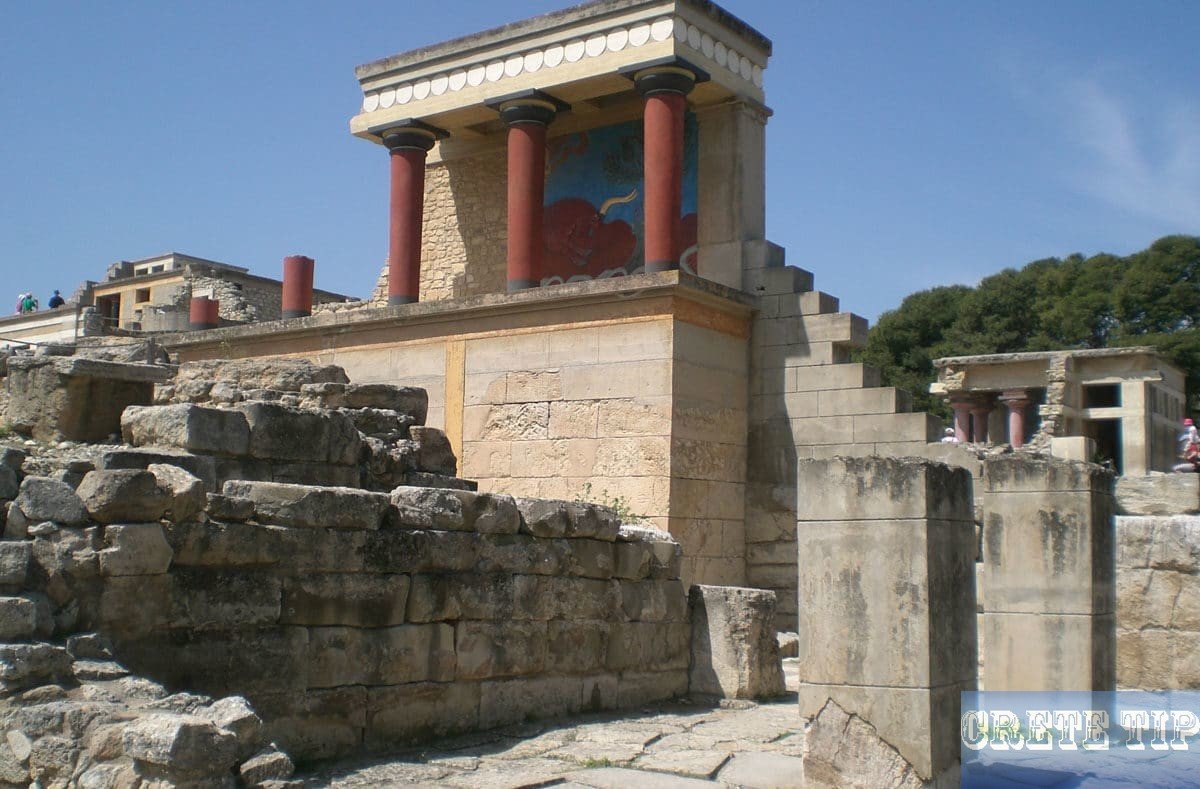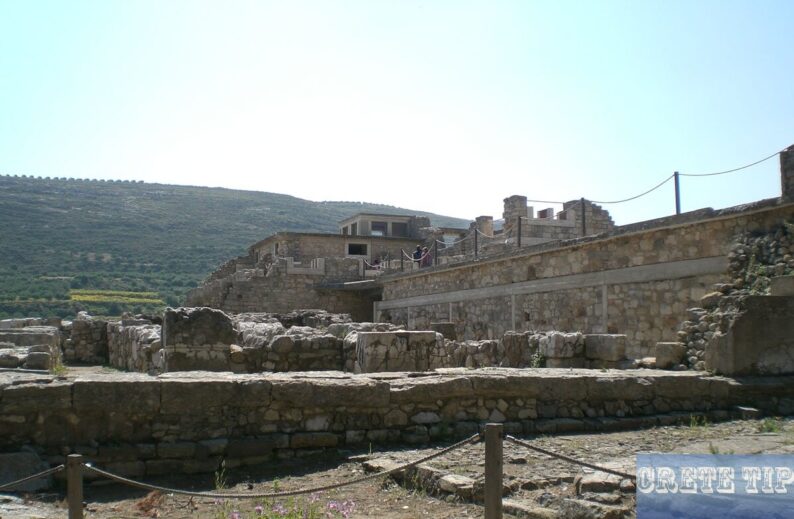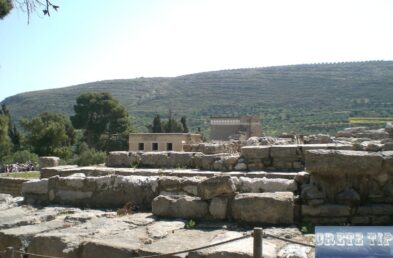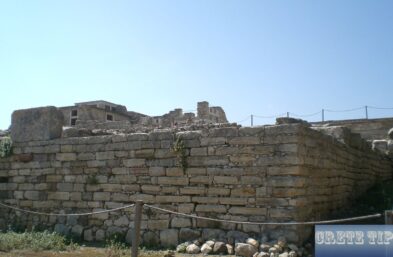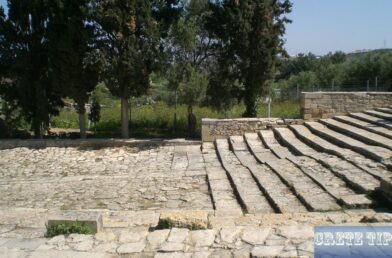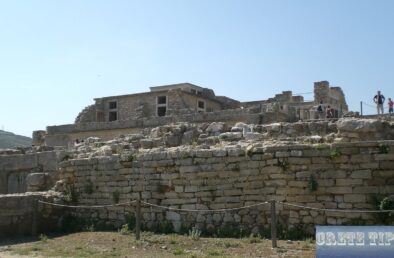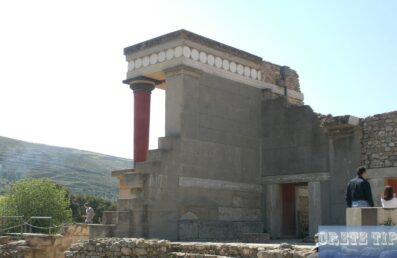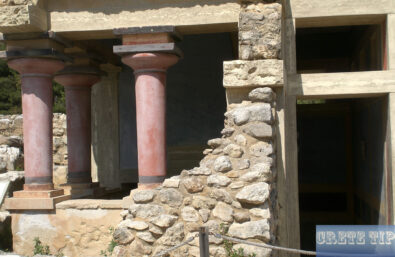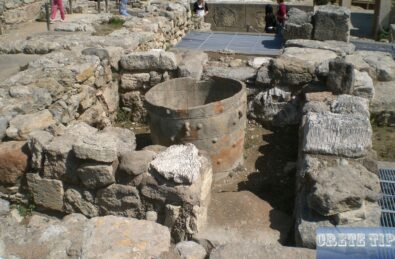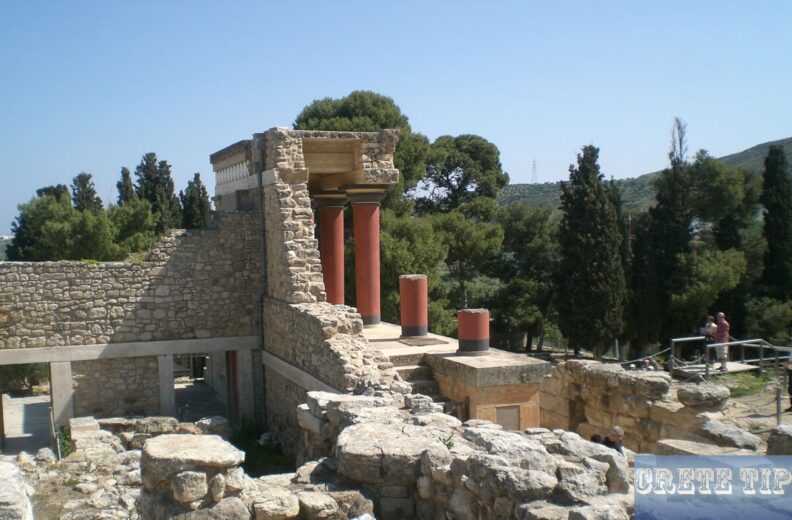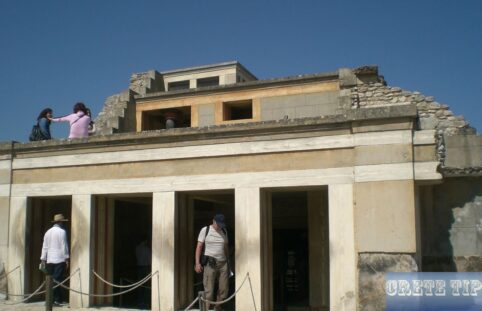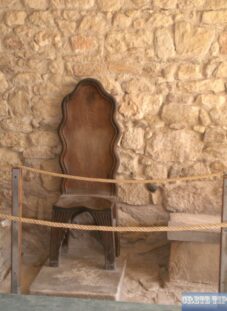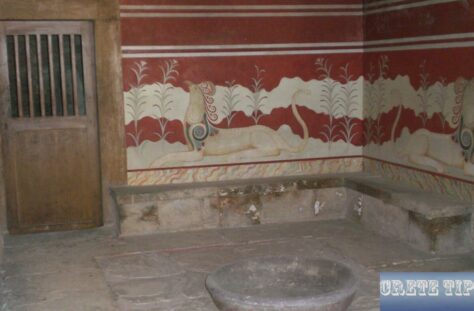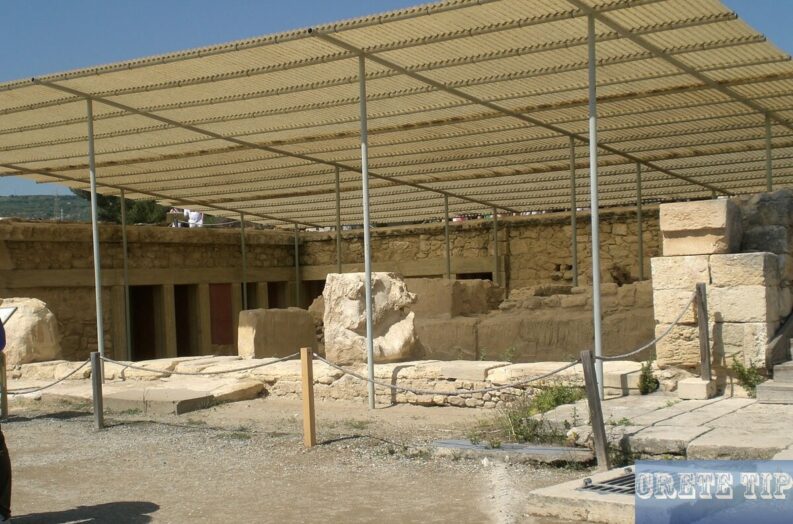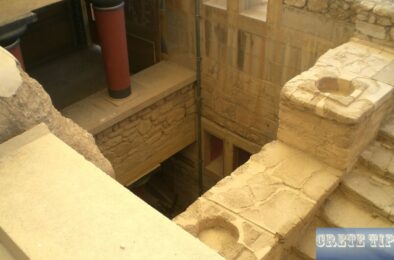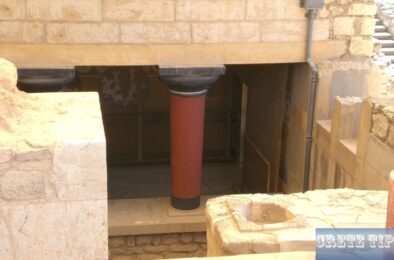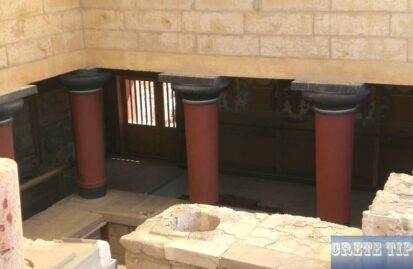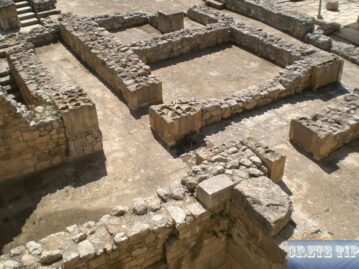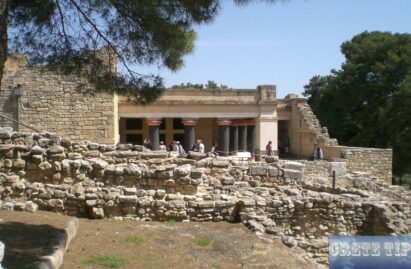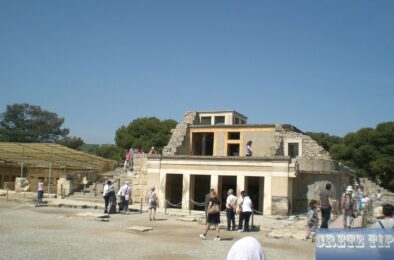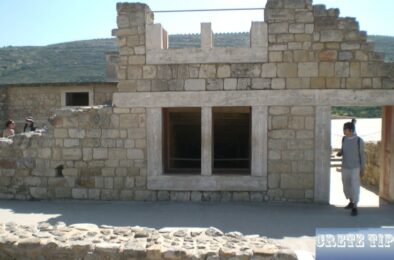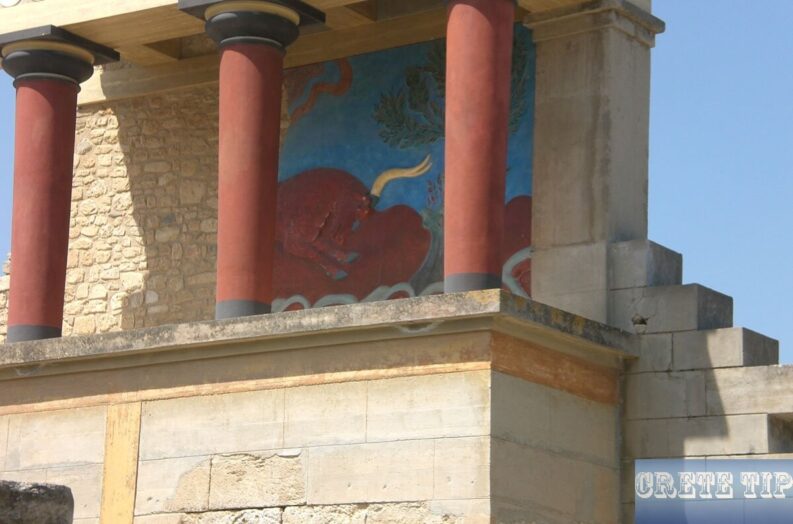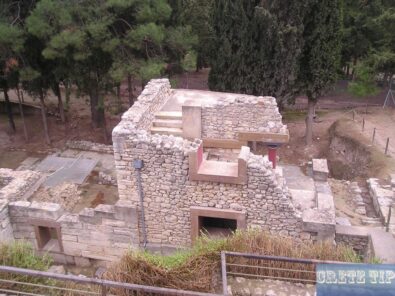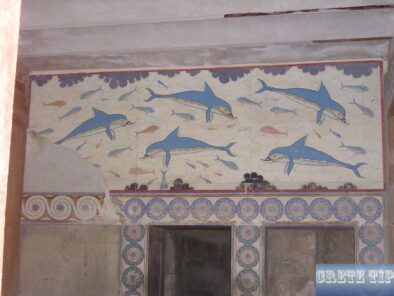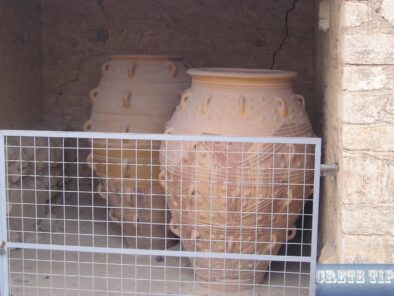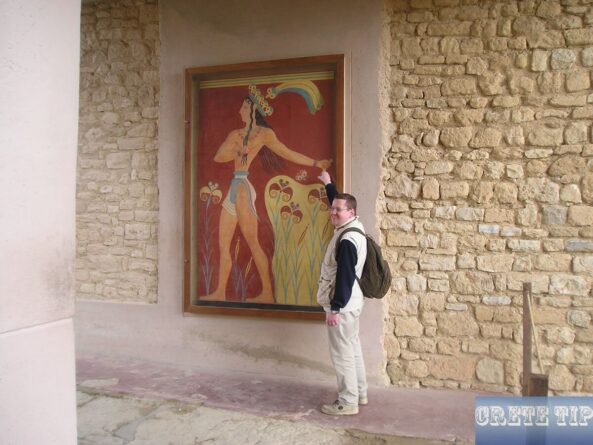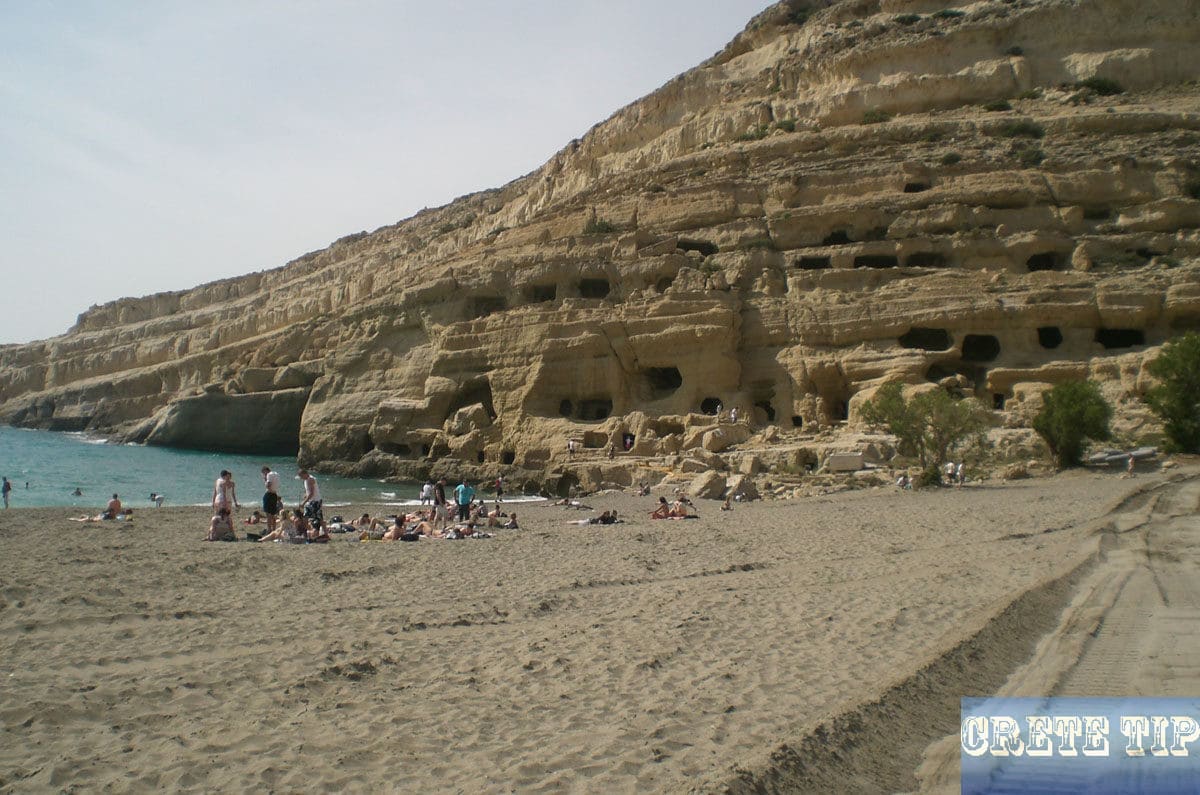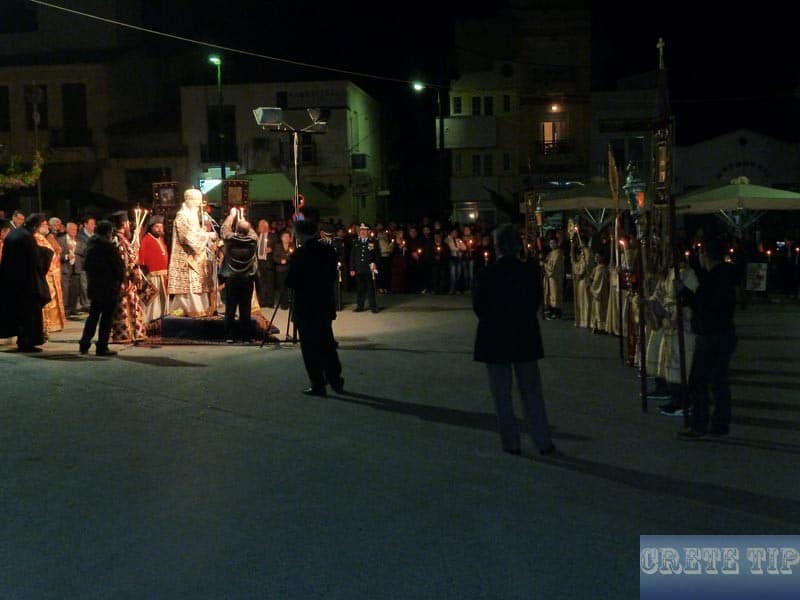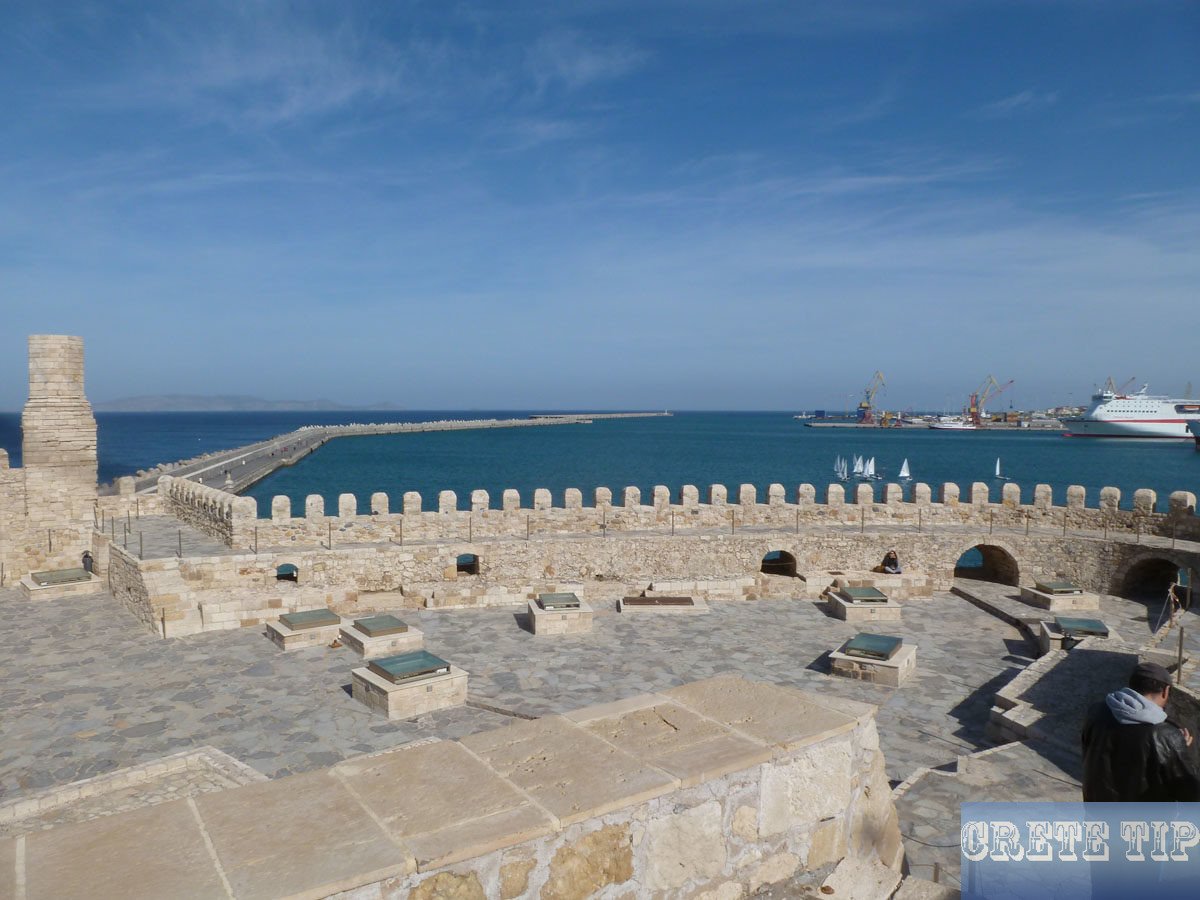Knossos, the largest Minoan palace on Crete. Its history, excavations and restorations with a visit of the palace grounds together with many pictures and video.
Knossos is located about 3 miles (ca. 5 km) south of Heraklion on a flat, largely artificially constructed hill, which was known in ancient times under the name ‘Tselepi’ or ‘Kefala’. There is by far the largest of the Minoan palaces found so far. There are also offers for guided tours to Knossos by bus and hotel transfer available.
History
Table of Contents
The area was settled at least since the Neolithic period around 6,000 BC. By the end of this period around 3,000 BC it was a larger settlement in a lush area on fertile soil, which was described by the poet Pindar as an ‘abundance of trees’.
The few remains from the Protopalatial period at Knossos indicate that an independent building complex was built around a central courtyard, which contains ruins from the Neolithic or Protopalatial period. The buildings were connected to each other and thus covered the courtyard, so that finally around 2,000 BC, a building complex existed with a courtyard to the north and another to the west.
Various extensions and improvements were made at various times during the Protopalatial period, which resulted in the first palace, which was destroyed by an earthquake around the year 1,700 BC.
The reconstruction of the destroyed palace took place according to a new architectural plan, more magnificent and on a larger area of over 200,000 sq ft (1.86 ha). The main new features were wings on the building complex. The most important wing was in the west, where the religious premises were located. The royal family lives in the premises in the east wing and the two others to the north and south contain multipurpose and storage areas.
The multistory buildings, three stories on the west side and five in the east, had majestic facades of carved stones, marble slabs, plaster work, magnificent frescoes and entrance gates, plaster floors, monumental staircases, painted columns and accented door frames that were both brilliant and majestic to their natural environment. This made the palace suitable for its two tasks, namely, the place where the gods lived, and secondly the seat of the ruling authorities, as the royal family and the priesthood.
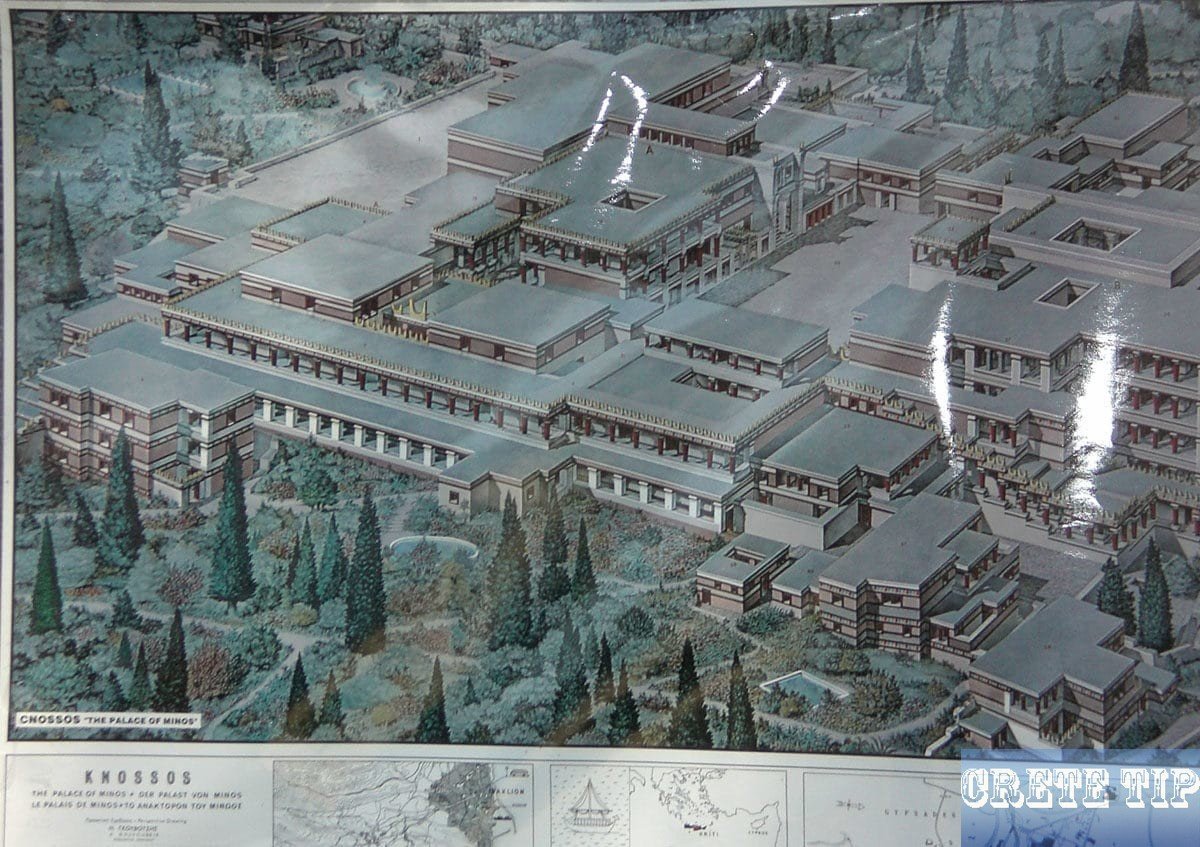
At this time, the new palace was surrounded by smaller mansions, like the ‘Royal Villa’, plus by a huge city of up to 100,000 inhabitants.
The new palace was also destroyed in 1,450 BC., probably due to the massive volcanic eruption on Santorini. But it was repaired immediately and used as the seat of the Achaean leader until 1,400 or 1,380 BC. Probably it was also used until 1,200 BC. Thereafter the palace was definitely destroyed and uninhabited.
At this time the prehistoric Knossos was still one of the largest cities of this period. This is testified by the extensive cemeteries that extend from Knossos to the heights of Profitis Ilias and Gypsades.
Throughout its existence, from ancient times to the Roman conquest, Knossos was still one of the most important cities in Crete. The city continued to exist until the early Byzantine period, but in the course of the Middle Ages it became a small village called Makris Toichos.
Excavations
The discovery and excavation of the palace is one of the most amazing stories of modern archeology. A little over a hundred years ago Knossos was only a place that existed in mythology.
The first excavations at the Palace of Knossos were started to a limited extent in 1878 by a resident of Heraklion, Minos Kalokairinos. He discovered several magazine rooms.
The German Heinrich Schliemann and discoverer of Troy presumed that here was a significant Minoan palace under the different hills, but he was refused permission by the local Ottoman authorities to excavate or to buy the plot.
After the Turks had to leave Crete, the English archaeologist Arthur Evans acquired the hill called Kephala (head). The main structure of the palace was excavated until 1903. Evans headed the excavations and controversial restorations in Knossos for 25 years. The works continued intermittently until 1931, and Evans published four books about it.
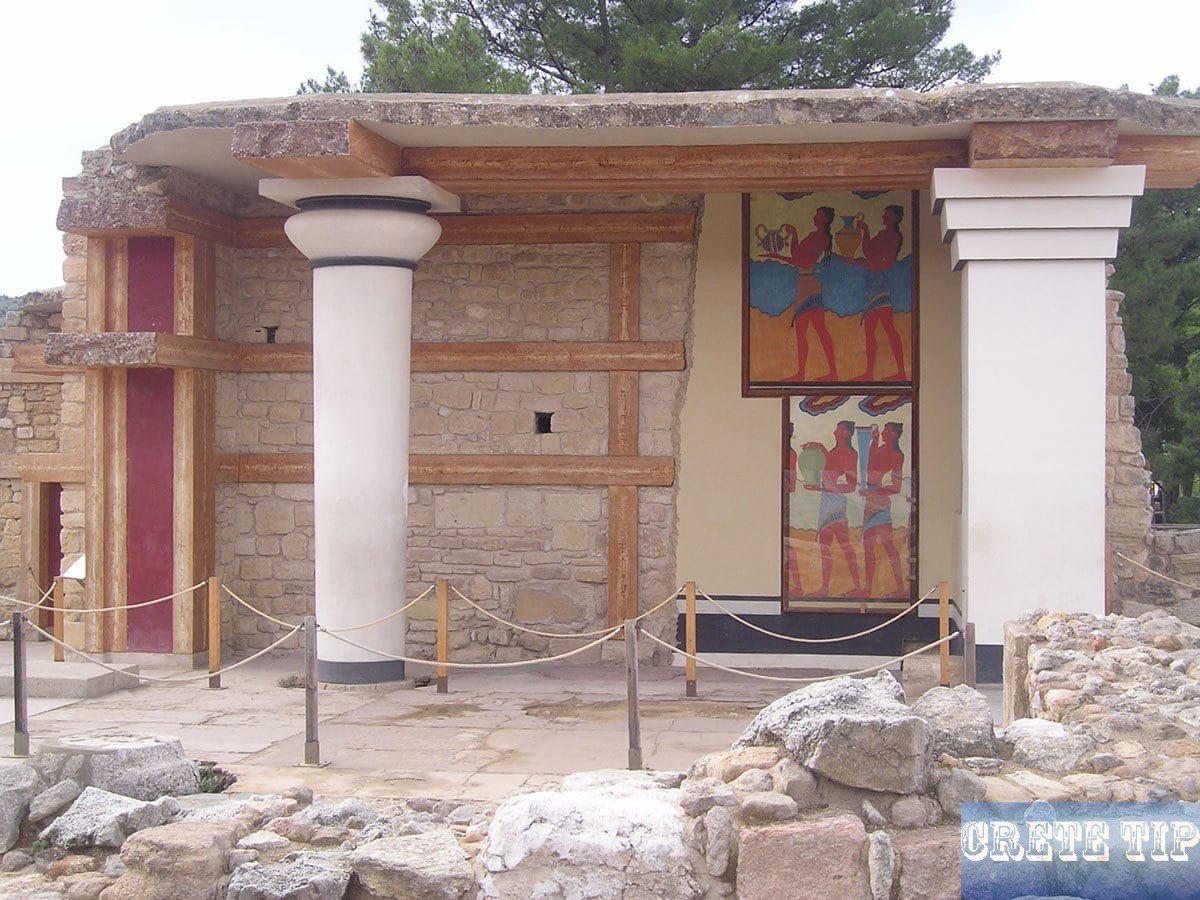
Evans rebuilt several parts of the palace and this was criticized by several historians and archaeologists, since he also used many materials that did not exist at the time of the Minoans, such as cement.
This reconstruction was justified by Evans with the need to preserve the various fragile buildings and parts. In addition, the impressive restoration also allows the architectural form of the palace to be visualized – a difference which is appreciated when one visit one of the other palaces of Festos, Malia or Zakros.
In any case, Evans criticized and even lauded restoration measures are essentially to the latest research. However, it is also clear that a large part of Evan’s upper level, the Piano Nobile, is a mere presumption. Still, his guess as the palace might have looked, is almost so likely as any other.
The Palace Grounds
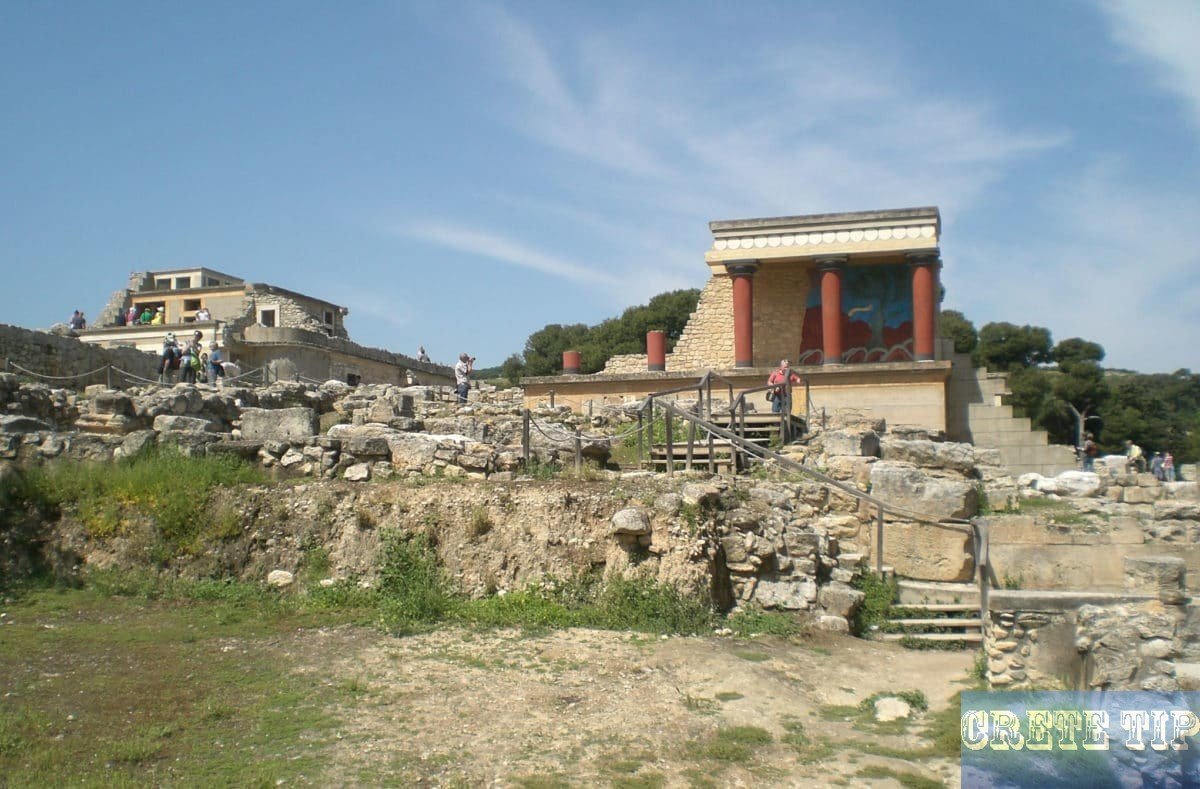
Today’s entrance to the palace leads to the large, cobbled west courtyard, which is crossed by two narrow procession stone bridges. A procession leads to the West Propylaea and the other leads obliquely to the area of the theater. The roads were designated as processional corridors, as the processions took place there. On the left side of the yard are three large, round pits, so-called Kouloures, whose meaning is not exactly clear. But it might have been sacred grain stores.
At the bottom of the two Kouloures are the remains of houses from the Protopalatial period. Two altars, one on the West facade and the other near the West Propylaea, indicate the holiness of the ground.
One enters the palace through the great Propylaea in the eastern corner of the courtyard over the long procession corridor, which was decorated with murals of life-size sacrifices.
In the whole palace, only copies of the frescoes and objects can be seen, since the originals are located in the Archeological Museum of Heraklion.
This corridor makes a turn to the east where the southern section is destroyed and you have a good view of the lower ‘south house’. One turns from the mighty sturgeon on the right, to the left, and after this further turn one arrives at the great Southern Propylaea. The corridor continued eastward until it met the other corridor that went from the central courtyard to the south gate.
The broad staircase leads to the upper floor of the sacred west wing, the so-called ‘Piano Nobile’, whose reconstruction is however controversial. Evans described the area in this way as the festivals and the sanctuary were there.
There are a number of square rooms with two columns and a large one with six columns, the ‘Tricolumnar Shrine’. The whole floor was decorated with murals of religious motifs.
There is another access to the ‘Piano Mobile’ via the staircase on the west side of the central courtyard. On the south side of the staircase are small apartments of religious character whose facade to the central courtyard is in the form of a three-parted shrine, and in the north the entrance hall to the throne room with a cult bath. There are four steps, low benches on the walls, a porphyry basin, and in the middle was a wooden throne, of which only a charred piece of wood was found.
Behind it is the fascinating throne room with frescoes. In the center of the north side is the unique, pink, throne of Minos, made of a block of alabaster stone. Stone benches run along the walls of the room. Opposite the throne is a pleasure pool and a small room at the back, which was probably used for the storage of objects.
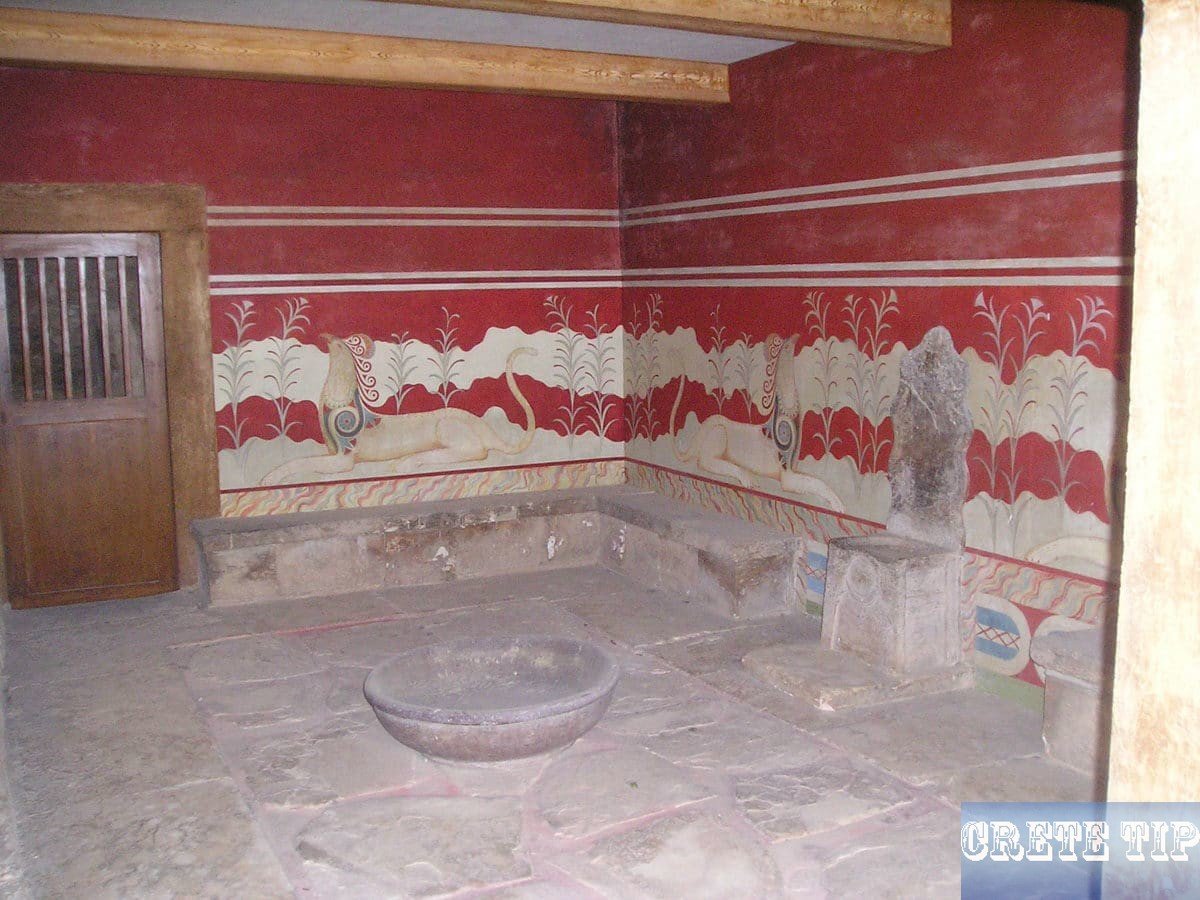
The most western rooms on the first floor consisted of 18 long and narrow storage rooms behind a corridor running parallel to the central courtyard. Above the ‘Piano Nobile’ are two rooms. The southern part is called the ‘Great Hall’ and in the north the ‘Holy Hall’.
A multistory building in which the Royal Apartments were located was on the east side of the central courtyard. At this point, the terrain falls to the river Kairatos, so that only the third floor reached the level of the central courtyard and the building had at least another floor.
There is a large staircase of the kind that was created later in Europe only during the baroque period. Originally the columns were made of cypress wood, the diameter in the upper section of the shaft increasing. There were also paintings with frescoes on the walls on the north and east sides leading to the royal apartments.
The lower stages of the staircases were found intact, while the others were reconstructed by Evans.
The Rooms of the King consisted of a group of large rooms with the ‘Hall of the Double Axes’ in the center, a room with a Polythyra (‘many doors’, pier-and-door arrangement) typical to the Minoans, which expanded the room and filled with light and fresh air. From the attached loggia you have a magnificent view over the deeply cut river valley.
Further south a broken line corridor leads to the smaller apartments for the women of the royal family. The most important room is the luxurious room called the ‘Megaron of the Queen’. Further west, another corridor leads to the ‘Boudoir of the Queen’ with a water drain and also a toilet with water purge. These rooms were amply decorated with frescoes of dolphins, dancing women and spirals.
The Royal Workshops, which continued the traditions of the Protopalatial period, were located in the northern part on the east side. The most important dwellings in the workshops were those of the stonemason, the potter and a workshop for the seal makers. Outside the palace, a plant for the smelting of ore for the production of bronze tools was found.
Further north are storage rooms with huge clay vessels.
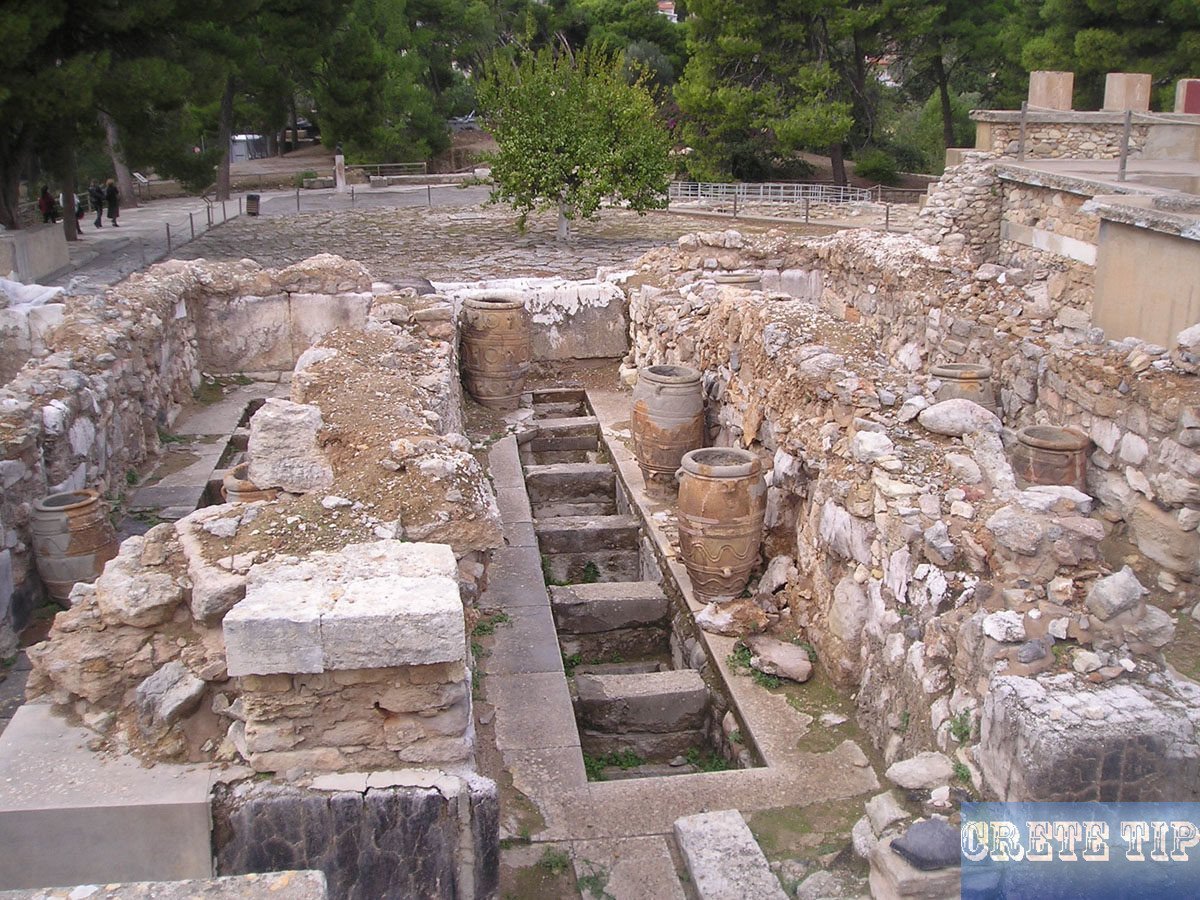
On the north side of the central courtyard, there is a corridor leading down to the restored west bastion, with a ramp in the west and a relic of a bull. It ends in a large hall with eight columns, which was called the ‘Customs station’, since here the cobbled street from the two ports of Amnisos and Katsambas ended.
Opposite, in the west, is the north gate of the palace.
East of the North Gate is another pleasure pool and a room with a Polythyra door and two pillars. Further west, a procession road leads to the theater area with steps on two sides and a bastion-like structure in a corner, which is thought to have been the royal loggia. A royal road led between important buildings to the ‘Little Palace’.
Around the palace were erected a whole series of buildings of similar architectural character, which must belong to the highest officials or dignitaries of the priesthood. To the west is the ‘Small Palace’, to the north-east the ‘Royal Villa’, to the southwest the House of the High Priest, that ‘South House’ and various more.
More pictures about the Palace of Knossos:
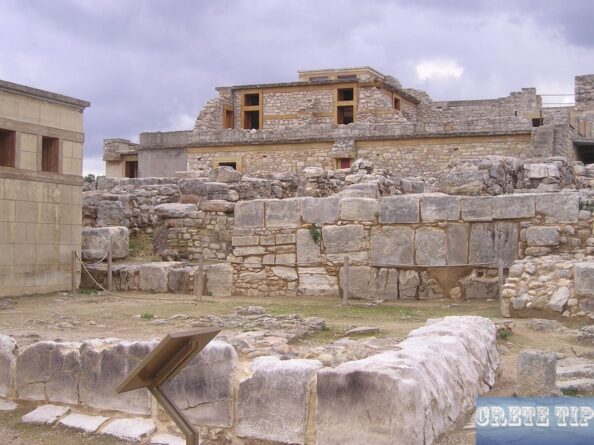
Visit
Opening hours: From July to September daily from 8 am to 8 pm. In May, June and October, Mondays to Saturdays from 8 am to 6 pm, Sundays from 8 am to 3 pm. From November to April daily from 8:30 am to 3 pm.
Entrance fee 6 Euros (with combi-ticket for the Archaeological Museum in Heraklion 10 Euros).
Knossos is also easily accessible by bus from Heraklion. However, due to the enormous visitor numbers of around 600,000 per year, a large amount of people, particularly during the high season, must be expected. It is therefore recommended during the summer to visit during the last few hours before closing, thus sparing the greatest masses of people and at the same time the greatest heat.
There are also guided tours to Knossos with bus transfer from hotels available.
All photos and videos taken on this page are either from the winter or at the beginning of the tourist season at the beginning of May, where there are relatively few visitors or hardly any visitors in winter.
Video about Knossos
(Duration 2 min 7 sec)
Directions to Knossos
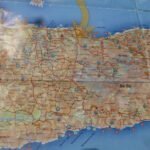
Click here: Directions Knossos.


